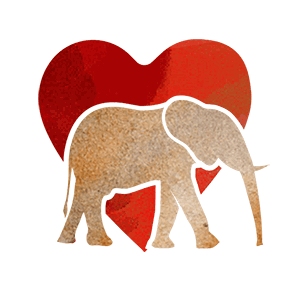The Nairobi Nursery received a report of an orphaned elephant calf at 2.30pm on the afternoon of Wednesday 21st August from Cynthia Moss in Amboseli. Cynthia Moss has been studying and researching the elephant populations of Amboseli for many years now but recently had been carefully watching a herd, named FA by the research team, with a young seven month old bull called Faraja who was born on the 28th January 2012, and whose mother recently vanished.
Faraja is a unique little elephant with a special difference to all the other orphans the David Sheldrick Wildlife Trust has rescued. Normally elephants are born with dark grey skin pigmentation and black hair and eyelashes, but Faraja is one of only two elephant calves born in Amboseli with distinct albino colourings. At birth the Amboseli research team observed that Faraja’s white hair and pale colourations were much more visible, having darkened slightly with age.
On the tail images below you can see how much lighter Faraja's tail hair is compared to Barsilinga's tail on the right.
The Amboseli elephant research team, suspecting that Faraja’s mother, named Fenella, had been speared by Maasai herdsman in the recent conflict incidents that cost the lives of a number of Amboseli’s elephants, informed the KWS head officer after failing to trace the mother or find a carcass, before calling the SWT rescue team to come immediately as the calf’s condition was visibly deteriorating, and it was clear to all he would not make it without intervention.
On the day of rescue the calf was found accompanied by young females from the HA family, formed of only three members, who were keeping him close and taking as much care of him as they could, as he had been somehow separated or abandoned by his FA herd. ‘Flickr’ as one of his young female cousins was named by the research team, was especially protective, showing the most concern. However none of them could give the vital milk that he required during the dry season to prevent his strength from ebbing away.
The SWT rescue team arrived at the Amboseli airstrip at 4pm and were met by the research team who transported them to the area where the calf was last seen. After searching for the family for an hour they finally located the herd and the calf, which was now looking very emaciated and weak in contrast to his condition when he was first spotted without his mother.
Using two vehicles the rescue team worked to get Faraja away from the protection of his cousins, who were rightfully aggressive, charging the vehicles in an attempt to protect the baby. After a short period the calf was successfully separated from the rest of the herd, captured quickly and carefully loaded into one of the vehicles to be taken to the airstrip.
The rescue plane was airborne just before 6pm, arriving at the Nairobi Nursery by 8pm where Faraja was immediately placed in a stockade having put up quite a fight with the keepers despite his weakened state. Refusing milk on the day of rescue he finally took milk at 3am the following morning, with Sities in the stockade next to him for reassurance and comfort.
Both the SWT, and Cynthia Moss and her dedicated elephant research team, know that an elephant calf such as Faraja cannot survive without his mother at such a delicate age. In order to survive Faraja needs his mother’s milk until he is at least two years old, which his female cousins could not possibly have provided. It is of course heartbreaking and extremely difficult to make the decision to remove an elephant from his natural family, but the alternative was to stand by and watch his strength and life ebb away while doing nothing.
On arrival he came into our care already extremely thin and weak for his size. Faraja now has a second chance at life and is young enough to embrace his new family with a new future, and has settled in extremely well. He is regaining strength and remains with the love and warmth of other elephants around him.






































